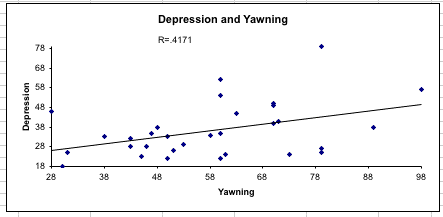- Examining
the connection
between
yawning
and depression Samuel R. Gallezzo
- Holyoke
Community College
- This study was proposed directly for
publication on the website.
-
- Samuel R. Gallezzo proposes a correlation
design study of the connection between the self
reported levels of yawning and depression
by 31 participants. The researcher administered
the Goldberg
Depression Inventory with a yawning
inventory questionnaire (Greco et Baenninger).
Correlations were computed between
yawning and depression and found to be
statistically significant. This study is unique
because it looks at the connection between
yawning frequency and levels of
depression. If yawning can be used as a
diagnostic tool to screen for depression more
people might be willing to seek help after
taking a yawning questionnaire. One
surprise, for the authors, in the results shows
a significant negative relationship between age
and yawning. It may be recall that the
physiological
decrease of yawning in the elderly suggests
an associated decrease of dopaminergic activity.
The link between depression and yawning is
probably not pertinent by agedness after 65
years old. On the other hand, clinicians may be
aware of yawning as a side-effect of
antidepressant therapy...
-
 -
- Ce travail étudie le lien qui peut
exister entre la fréquence des
bâillements rapportés par des
consultants dépressifs (31) et
l'importance de la dépression. La
dépression a été
estimée à l'aide de l'échelle
d'évaluation de Golberg, les
bâillements estimés à l'aide
du questionnaire
proposé par Greco et Baenninger.
L'analyse statistique des résultats
retrouve un lien significatif: plus le patient
bâille, plus son état
dépressif est sévère. C'est
la première fois que ce type
d'étude est réalisée.
-
- Si l'étude des bâillements est
un moyen d'apprécier l'état
dépressif, l'usage de questionnaires
appréciant les bâillements peut
être proposé comme aide au
diagnostic. Une des surprises, pour les auteurs
de cette étude, est la corrélation
négative entre âge et
bâillements. Il faut rappeler que le
nombre de bâillements diminue
physiologiquement avec l'âge, et qu'il
est probable que le lien entre bâillements
et dépression perd de sa valeur
prédictive après 65 ans. Il faut,
d'autre part, mettre en garde les praticiens:
les anti dépresseurs, en particulier
sérotonergiques, favorisent des
bâillements
répétés.
-
- La
fatigue Angelo
Mosso 1896
- Les
états
neurasthéniques
Georges Gilles de la Tourette
1898
- Le
bâillement physiologique et
pathologique
Albert Salmon 1948
- La
neurasthénie
Klippel M 1928
-
- Examining
the connection
between
yawning
and depression Samuel R. Gallezzo
- Holyoke
Community College
-
- An ethological
interpretation of stereotypy induced by
environmental stimulus Beckmann H, Zimmer R
Arch Psychiatr Nervenkr
1981; 230; 1; 81-!9
-
- On the
context of yawning: when,
where, and why? Greco M, Baenninger
R The Psychological
Record 1993, 43,
175-183
-
- Monitoring
improvement using a patient-rated depression
scale during treatment with anti-depressants in
general practice: a validation study on the
Goldberg depression scale Holm, J., Holm, L.
and Bech, P Scandinavian J of
Primary Health Care
2001;19(4) 263-266.
-
- Yawning : a
homeostatic reflexe and its psychological
signifance. Lehmann H. Bull
Menninger Clinic 1979; 43; 123-126
-
- Hensch
T, Blume A, Böttger D, Sander C,
Niedermeier N, Hegerl U. Yawning in
Depression: Worth Looking Into.
Pharmacopsychiatry. 2015;48(3):118-120
-
- Antidepressant-Induced
Yawning Khawaja H, Sanjel A, Upadhyay E,
Khawaja IS Prim Care Companion CNS Disord 2021;
23(2): 20l02713
-
-
- Yawning
as a side-effect of antidepressant
therapy
- Le
bâillement, un effet secondaire
des traitements
antidépressifs
-
|



